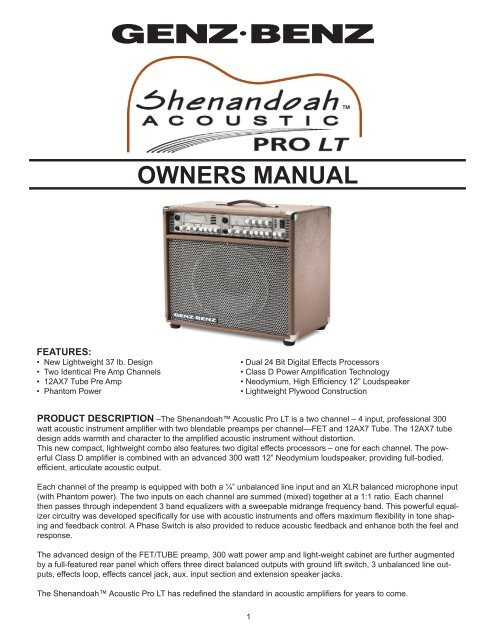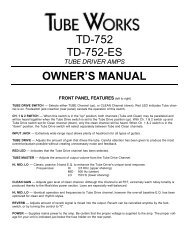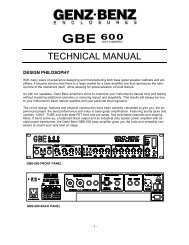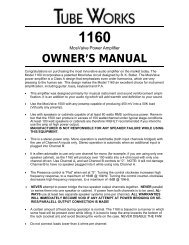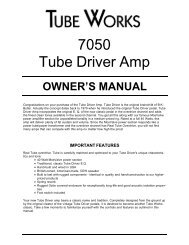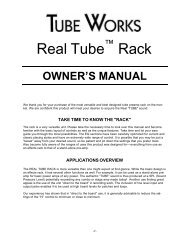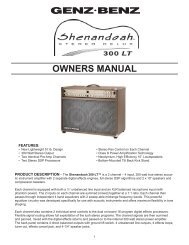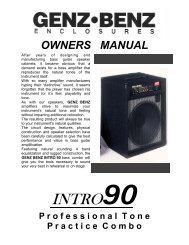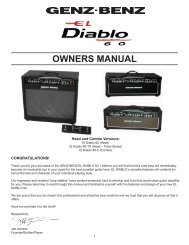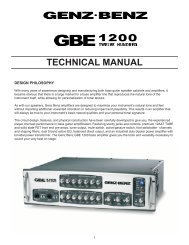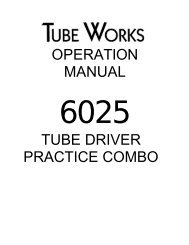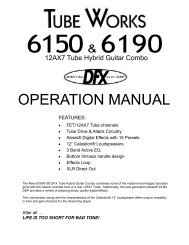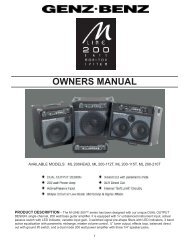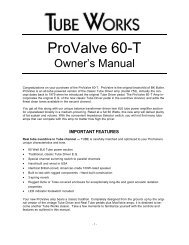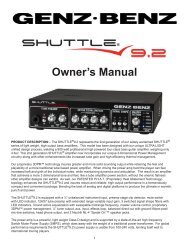Shenandoah Pro LT - Genz Benz
Shenandoah Pro LT - Genz Benz
Shenandoah Pro LT - Genz Benz
You also want an ePaper? Increase the reach of your titles
YUMPU automatically turns print PDFs into web optimized ePapers that Google loves.
OWNERS MANUAL<br />
FEATURES:<br />
• New Lightweight 37 lb. Design • Dual 24 Bit Digital Effects <strong>Pro</strong>cessors<br />
• Two Identical Pre Amp Channels • Class D Power Amplification Technology<br />
• 12AX7 Tube Pre Amp • Neodymium, High Efficiency 12” Loudspeaker<br />
• Phantom Power • Lightweight Plywood Construction<br />
PRODUCT DESCRIPTION –The <strong>Shenandoah</strong> Acoustic <strong>Pro</strong> <strong>LT</strong> is a two channel – 4 input, professional 300<br />
watt acoustic instrument amplifier with two blendable preamps per channel—FET and 12AX7 Tube. The 12AX7 tube<br />
design adds warmth and character to the amplified acoustic instrument without distortion.<br />
This new compact, lightweight combo also features two digital effects processors – one for each channel. The powerful<br />
Class D amplifier is combined with an advanced 300 watt 12” Neodymium loudspeaker, providing full-bodied,<br />
efficient, articulate acoustic output.<br />
Each channel of the preamp is equipped with both a ¼” unbalanced line input and an XLR balanced microphone input<br />
(with Phantom power). The two inputs on each channel are summed (mixed) together at a 1:1 ratio. Each channel<br />
then passes through independent 3 band equalizers with a sweepable midrange frequency band. This powerful equalizer<br />
circuitry was developed specifically for use with acoustic instruments and offers maximum flexibility in tone shaping<br />
and feedback control. A Phase Switch is also provided to reduce acoustic feedback and enhance both the feel and<br />
response.<br />
The advanced design of the FET/TUBE preamp, 300 watt power amp and light-weight cabinet are further augmented<br />
by a full-featured rear panel which offers three direct balanced outputs with ground lift switch, 3 unbalanced line outputs,<br />
effects loop, effects cancel jack, aux. input section and extension speaker jacks.<br />
The <strong>Shenandoah</strong> Acoustic <strong>Pro</strong> <strong>LT</strong> has redefined the standard in acoustic amplifiers for years to come.<br />
1
FRONT PANEL<br />
INPUTS - The <strong>Shenandoah</strong> Acoustic <strong>Pro</strong> <strong>LT</strong> is equipped with two types of input jacks. The ¼” input is unbalanced<br />
and “line/instrument level” with a usable sensitivity from 80 mV to 1.25 volt. The input impedance is 220 k ohms.<br />
The ¼” input will also accept most active balanced line sources, automatically unbalancing them by recognizing the<br />
tip portion of the balanced signal. If an instrument offers an unbalanced output it should be connected to the<br />
unbalanced input of the <strong>Shenandoah</strong> amp. Additionally, the precision input scaling preamp contains a 45 Hz, 12<br />
dB/octave high pass filter (more effective and less intrusive than the more common 6 dB filters) and an “RFI” filter<br />
(radio frequency interference) to eliminate unwanted noise. The XLR input jack is balanced and “microphone<br />
level”, with a usable sensitivity from -60 dBv to -30 dBv. It is not a line level input. It contains a precision full range<br />
differential microphone preamp with phantom power. For use with higher-level sources (such as the balanced line<br />
level output from a keyboard or other instruments), a balanced pad network will be necessary to use the balanced<br />
input. For instance, a Rapco “Pad Blox”, -20 or -30 pad or similar product could be used.<br />
PHANTOM POWER - An internal phantom power source (12 volts) is provided for use with condenser mics. This<br />
power source is on at all times and does not affect the standard operation of the amp, even when a condenser mic<br />
is not used. We use the DIN 45-596-P12 volt standard, which will operate virtually all of the live sound<br />
reinforcement condenser microphones on the market. Some “boutique” externally biased condenser mics will not<br />
be compatible and will require 48 volt phantom power. We suggest live sound condenser mics by: AKG, Audio<br />
Technica, CAD, Shure, and Crown.<br />
PREAMP GAIN CONTROL – This level control sets the amount of gain at the Input of the Preamp. Use this control<br />
to set the input level in conjunction with the CLIP LED indicator.<br />
INPUT CLIP LED – The red CLIP LED senses the input signal to the preamp section and warns of input overload.<br />
For the cleanest signal possible, this LED should only flash with the strongest signal peaks. Adjust this sensitivity<br />
with the input volume control.<br />
PHASE SWITCH – Each input is provided with a phase reverse switch. By reversing the phase of the input signal,<br />
feedback tendencies can be reduced if caused by sympathetic vibrations between the speaker and the instrument.<br />
Under some conditions, changing the phase can drastically improve the output from the amplifier and can improve<br />
the playability of some instruments.<br />
FET/TUBE PREAMP BLEND CONTROL – Each input channel is provided with a preamp blend control, which<br />
adjusts the balance of the input signal between the FET and 12AX7 TUBE preamp. The FET preamp produces<br />
smooth, articulate response while the TUBE preamp enhances the acoustic guitars timbre with the warm tonal<br />
characteristics of the TUBE but without distortion when driven hard. It will be helpful to experiment with this blend<br />
control to find the position that best suits your desired tone and playing style. The ability to choose or mix these two<br />
preamps is a unique and exceptional feature of the <strong>Shenandoah</strong> Acoustic <strong>Pro</strong> <strong>LT</strong> amplifier design. Note: From a<br />
cold start, it will take 7—10 seconds for the tube to warm up and pass audio.<br />
2
COMBINING XLR & ¼” INPUTS – A unique feature of the <strong>Shenandoah</strong> Acoustic <strong>Pro</strong> <strong>LT</strong> is the ability to mix the<br />
XLR balanced and ¼” unbalanced inputs on each channel. In many situations, this effectively makes the amplifier<br />
function as a 4-channel amplifier. The most effective way to use this feature is to set the volume on the channel<br />
using the XLR microphone input and then adjust the level control on the instrument itself (assuming that it has<br />
one) to blend levels between the two inputs. Equalization will be common to both inputs on the channel.<br />
ON-BOARD DIGITAL EFFECTS – The <strong>Shenandoah</strong> Acoustic <strong>Pro</strong> <strong>LT</strong> contains two studio quality 15 program<br />
digital effects processors. We chose industry standard digital signal processing for realistic, high quality effect<br />
algorithms. Not all effects will be suitable for all types of instruments or playing styles, but everyone should find a<br />
good selection of solid, usable programs. Just keep in mind that a program that doesn’t work well for your acoustic<br />
guitar or mandolin work (long lush reverbs for example) may be the perfect program for jazz guitar, sax or flute.<br />
Effects volume differences are normal when switching between different effects programs. Adjust the effects send<br />
and master levels accordingly.<br />
One of the most powerful features of this DSP engine is its ability to process a large amount of audio data in realtime.<br />
This allows us to take advantage of several important concepts in generating a believable acoustic image.<br />
By delaying a portion of the signal by an “early reflection ratio”, applying DSP processing to this signal, then summing<br />
it back with the original signal and returning the mix to the program bus, the resulting sound is big, lush and<br />
exceptionally stable. A ¼” TRS effects cancel jack is provided on the back panel to mute the internal effects via<br />
footswitch. Any standard 2-button latching footswitch may be used. The effects signal is muted when the switch is<br />
closed, shorting tip (or ring) to sleeve.<br />
PROGRAM DESCRIPTION<br />
NAME DESCRIPTION<br />
Hall 1 Bright hall reverb<br />
Hall 2 Warm hall reverb<br />
Room 1 Hardwood studio reverb<br />
Room 2 Ambient room reverb<br />
Room 3 Warm room reverb for guitars and rhythm instruments<br />
Plate 1 Classic plate reverb for lead vocals and instruments<br />
Plate 2 Sizzling bright plate reverb for vocals<br />
Plate 3 Short “vintage” plate reverb<br />
Chorus Chorus (Tonal variations in pitch and volume)<br />
Flange Flanger for jet wash effects<br />
Delay 1 125ms slapjack delay<br />
Delay 2 190ms slapjack delay<br />
Chorus/Plate Chorus with reverb plate<br />
Chorus/Room Auto-wah guitar effect with reverb<br />
Bypass No effect<br />
Pitch Shift Rotary Rotary speaker emulation<br />
ACTIVE 3 BAND EQUALIZATION – Each channel of the <strong>Shenandoah</strong> Acoustic <strong>Pro</strong> <strong>LT</strong> contains a separate 3<br />
band (with sweepable midrange frequency) active equalizer. These equalizers, similar to those found on professional<br />
sound consoles, are very useful tools when used correctly.<br />
LOW FREQUENCY EQ - The corner frequency of the low frequency section is 125 Hz, with a shelving curve type<br />
and provides cut or boost of 15 dB. This frequency is particularly handy when dealing with low frequency feedback<br />
from a big dreadnaught guitar, cello, or upright bass. With a “boomy” instrument on a small stage, a combination<br />
of volume reduction and turning down the low frequency control will generally get good results. The low frequency<br />
control is also handy for adding some “bottom” to a baritone sax and “chunk” to many stringed instruments.<br />
3
HIGH FREQUENCY EQ - The corner frequency of the high frequency section is 8 kHz, shelving curve type and<br />
provides cut or boost of 15 dB. This frequency is especially useful for taming the bright harshness of some<br />
mandolins, violins, brass, and reeds. It can also be used to help acoustic guitars, cellos, and flutes cut through other<br />
players in loud club situations, or where drums are present.<br />
MIDRANGE EQ - The “sweep mid” section features an independent midrange equalizer, peaking curve type, with over<br />
15 dB of cut or boost and a bandwidth approximately 1 octave wide. The center frequencies of these equalization filters<br />
are continuously user adjustable from 250 Hz to 5 kHz with the corresponding frequency control. These filters are typically<br />
(but not always) used to reduce or remove offending frequencies in the instrument’s pick-up response. Removing<br />
only the minimum amount necessary will yield the most acoustically rewarding results. The easiest and most repeatable<br />
way to determine the offending frequency range is to boost the mid level somewhat (but not to the point of feedback)<br />
and then while playing, sweep the frequency control slowly across its range. You may need a third hand until it becomes<br />
second nature, but soon you will find out just how quick it can be. You will hear a clear and obvious accentuation<br />
of the “ugliness” you wish to remove. Then, reduce the gain control until the sound you desire is attained. The ear is a<br />
most sensitive and discriminating piece of test equipment when used in this manner — another good reason to protect<br />
them! This is the way many touring sound engineers equalize, since it is quick, accurate and repeatable. Occasionally,<br />
you will find need to use the mid section in “boost” mode, particularly common when adding higher midrange (bite) to<br />
an otherwise dull instrument, or adding low mid “body” to an otherwise thin sound. Spend some time experimenting so<br />
that the process becomes creative as well as corrective.<br />
AUXILIARY INPUT LEVEL CONTROL – The <strong>Shenandoah</strong> Acoustic <strong>Pro</strong> <strong>LT</strong> is equipped with both ¼” and dual RCA<br />
aux. input jacks and an aux. level control. These rear panel jacks are internally summed and feed the stereo mix via the<br />
aux. level control. Both aux. inputs are line level for use with drum machines, CD, iPod, MP3 and tape players.<br />
MASTER VOLUME – The Master Volume control adjusts the overall volume of the mix of channel 1, channel 2, aux.<br />
input and effects return. Typically, best results are obtained when this control is operated between the 9:00 and 3:00<br />
positions.<br />
MASTER STATUS LED INDICATORS - The LED’s are provided in the master section and display the operational<br />
states of the amplifier. There will be a slight delay during turn on activating the stand-by LED. The operate LED will<br />
come on when the unit is turned on. The signal LED measures the presence of an audio signal passing through the<br />
power amp.<br />
BACK PANEL<br />
SPEAKER OUTPUTS – Two ¼” output jacks are provided for connection to your speakers, one is used for the internal<br />
combo speaker and the other is used for connection to an 8 ohm external speaker. Do not ground either terminal<br />
of these jacks, or short the terminals together.<br />
4
EFFECTS LOOP – The <strong>Shenandoah</strong> Acoustic <strong>Pro</strong> <strong>LT</strong> is equipped with an effects loop insert point into the main<br />
amplifier signal path. This loop is useful for inserting compressors and dedicated digital effects processors. The<br />
signal is line level and unbalanced.<br />
EFFECTS JACK – A ¼” TRS effects cancel jack is provided on the back panel to mute the internal effects via<br />
footswitch. Any standard 2-button latching footswitch may be used. The effects signal is muted when the switch<br />
is closed, shorting tip (or ring) to sleeve.<br />
DIRECT OUTPUTS – The <strong>Shenandoah</strong> Acoustic <strong>Pro</strong> <strong>LT</strong> contains the most comprehensive direct output section<br />
available on any acoustic instrument amplifier. The XLR balanced and ¼” unbalanced outputs make “real world<br />
sense” when connecting with other equipment. The ¼” unbalanced outputs are true professional line level<br />
(+4 dBv) with an output impedance of 1k ohm, and can drive virtually any line level input, including power amplifiers.<br />
The XLR balanced output is “hot” Mic level, rated at –30 dBv. This configuration allows the <strong>Shenandoah</strong><br />
Acoustic <strong>Pro</strong> <strong>LT</strong> to drive very long cable lengths (250+ feet) without problems or added noise and is compatible<br />
with all commonly encountered mixing consoles. The XLR balanced direct outputs can be “ground lifted” with<br />
the global ground lift switch. This switch lifts pin 1 on all of the XLR balanced outputs to break any ground loops<br />
between the <strong>Shenandoah</strong> Acoustic <strong>Pro</strong> <strong>LT</strong> and a PA system (or recording) console. Direct outputs are provided<br />
for each channel. Channel 1 and Channel 2 outputs are post channel volume/pre effects (to take advantage of<br />
the dual inputs on each channel) while the Channel 1+2 output is post master volume/post eq/post effects to aid<br />
in sending a “finished” mixed signal to a PA system or external power amplifier.<br />
POWER AMPLIFIER – The <strong>Shenandoah</strong> Acoustic <strong>Pro</strong> <strong>LT</strong> uses a state of the art, class D power amplifier design<br />
and a high frequency switch-mode power supply (SMPS) to achieve unprecedented high performance and<br />
lightweight packaging. The switch-mode power supply utilizes high frequency switching to reduce the size and<br />
weight of the magnetic and filter components while increasing the performance by recharging the power supply<br />
rails about 120,000 times each second! The class D amplifier uses digital PWM (pulse width modulation) techniques<br />
similar to those in more familiar digital to analog converters to reduce the size and weight by a factor of 10<br />
times that of a comparably rated conventional class AB amplifier. Additionally, we developed our own, proprietary<br />
limiting and signal processing techniques to give a distinctly analog feel and sound to the class D platform.<br />
POWER INPUT – The <strong>Shenandoah</strong> Acoustic <strong>Pro</strong> <strong>LT</strong> utilizes an auto-selecting, self-configuring universal power<br />
supply that operates from 100V to 240 volts, 50 to 60 Hz for worldwide use. Simply utilize the proper IEC cord-set<br />
appropriate for the country the product is being used in. There is an AC mains (line) fuse located in a slide-out<br />
tray at the bottom of the IEC power inlet socket. This is a Slo-Blo 3.15A fuse for all input voltages.<br />
TWEETER LEVEL CONTROL – A Tweeter Level Control is provided for maximum tonal flexibility. The “rockerswitch”<br />
control offers FULL tweeter output, - 6 dB level or tweeter OFF position. Experiment with the different<br />
settings to find the best position for your personal taste.<br />
SPEAKER CABINET CONFIGURATION – This high-powered professional product is constructed from birch<br />
and sustainable plywood’s, resulting in an extremely lightweight enclosure with excellent projection and tone.<br />
A bottom-mounted, tilt-back stand is provided so that the speaker can be tilted up towards the performer. The<br />
loudspeaker is our custom designed GNX12300 cast-frame 12” neodymium magnet structure with a precision<br />
edge-wound voice coil and Kapton bobbin, which is extremely efficient and lightweight compared to conventional<br />
speaker motor structures. A compression tweeter is utilized for the high frequency reproduction and delivers articulate,<br />
pristine, clarity and texture.<br />
5
SAFE OPERATING REQUIREMENTS:<br />
• Never set an amplifier on anything that will tip over or collapse under its weight.<br />
• <strong>Pro</strong>vide a minimum distance of 25.4 mm (1 inch) around all sides of the amplifier for sufficient ventilation. The<br />
ventilation should not be impeded by covering the amplifier’s vent openings with items such as newspapers, table<br />
cloths, curtains, etc.<br />
• No naked flame sources, such as lighted candles, should be placed on the <strong>Shenandoah</strong> Acoustic <strong>Pro</strong> <strong>LT</strong> amplifier.<br />
• This amplifier should not be exposed to dripping or splashing and no objects filled with liquids, such as vases or drinks,<br />
shall be placed on this product.<br />
• The <strong>Shenandoah</strong> Acoustic <strong>Pro</strong> <strong>LT</strong> amplifier should be connected to a mains socket outlet (power receptacle) with a<br />
protective earth (ground) connection at all times.<br />
• The amplifiers mains plug (power plug) is considered the disconnect device and the connection must remain accessible<br />
at all times.<br />
• This amplifier is capable of producing sound pressure levels that may cause hearing loss.<br />
• There are no user serviceable parts and hazardous operating voltages are present inside this unit. Always consult a<br />
qualified repair facility for service.<br />
WARNING!<br />
• The use and operation of this device constitutes an agreement of full release of any and all liability connected with its<br />
use. Only persons familiar with the operation of high-powered professional audio equipment should attempt to operate<br />
this device.<br />
• In addition, by use of this device, the user agrees to hold <strong>Genz</strong> <strong>Benz</strong> and its designers, sales agents and all other<br />
affiliates and related parties harmless in the event of any accident, injury, damage or loss resulting from such use.<br />
• Manufacturer’s sole responsibility is to provide a warranty on the specified performance of the product under normal<br />
operating conditions for a period of 3 years.<br />
WARRANTY:<br />
• <strong>Genz</strong> <strong>Benz</strong> warrants the model <strong>Shenandoah</strong> Acoustic <strong>Pro</strong> <strong>LT</strong> to be free from defects in materials and workmanship<br />
for a period of 3 years from the date of purchase, when purchased from an authorized <strong>Genz</strong> <strong>Benz</strong> dealer.<br />
• This warranty does not cover normal wear and tear incurred from the normally designed use of the product.<br />
• This warranty is effective only if a copy of the original sales receipt is presented at the time of warranty service.<br />
• This limited warranty is completely transferable to any subsequent buyer as long as the original sales receipt is also<br />
transferred to such subsequent buyer.<br />
• All warranty service must be performed by a <strong>Genz</strong> <strong>Benz</strong> authorized service center.<br />
• Before returning any unit for service, a returned merchandise authorization number (RMA#) must be obtained by calling<br />
480-941-0705<br />
• This warranty is valid in the US and Canada only. For all products sold outside the USA, warranty is handled through<br />
our international distributor for each country. For more information visit, our website: www.genzbenz.com<br />
6
<strong>Shenandoah</strong> Acoustic <strong>Pro</strong> <strong>LT</strong><br />
ENGINEERING SPECIFICATIONS<br />
INPUTS<br />
XLR Balanced channel input impedance: 2.2 k ohms<br />
XLR Balanced channel input sensitivity: -60 to –30 dBV<br />
¼” Unbalanced channel input impedance: 220 k ohms<br />
¼” Unbalanced channel input sensitivity: -22 to +2 dBV<br />
¼” Unbalanced aux. input impedance: 10 k ohms<br />
¼” Unbalanced aux. input sensitivity: -14 to +4 dBV<br />
Phantom power (XLR Inputs) +12V<br />
AMPLIFIER OUTPUT<br />
Power at 8 ohm load: 175 watts RMS<br />
Power at 4 ohm load: 300 watts RMS<br />
THD + N (preamp):
DECLARATION OF CONFORMITY<br />
(89/336 EEC-EMC Directive)<br />
Manufacturer’s Name: <strong>Genz</strong> <strong>Benz</strong>, a division of KMC Music<br />
Manufacturer’s Address: 7811 East Pierce Street<br />
Scottsdale, AZ 85257, U.S.A.<br />
<strong>Pro</strong>duct Type: Audio Amplifier<br />
Model Number: <strong>Shenandoah</strong> Acoustic <strong>Pro</strong> <strong>LT</strong><br />
Operating Power Condition: 100/115/230/240V 50/60Hz<br />
Effective Date: 01-01-2008<br />
Conforms to the Following Standards: [X] EN 55013: 2001 + A1: 2003<br />
[X] EN 55020: 2002 + A1: 2003<br />
[X] EN 60065: 2001 + A1<br />
[X] IEC 61000-3.3: 1994 + A1: 2001<br />
[X] IEC 61000-4.2<br />
[X] IEC 61000-4.3<br />
[X] IEC 61000-4.4<br />
[X] FCC 15.107 and 15.109<br />
[X] RoHS Directive 2002/95/EC<br />
[X] WEEE Directive 2002/96/EC<br />
[X] CE Mark LV Directive 73/23 EEC<br />
REV 6<br />
A KMC Music Corporation, Bloomfield, CT<br />
7811 E. Pierce St. Scottsdale, AZ 85257<br />
Ph: 480-941-0705 Fax: 480-946-2412<br />
www.genzbenz.com


